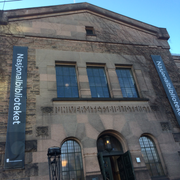Seminar Report: Notated Music in the Digital Sphere
Monday, November 26, 2018

Will there ever be a Google Books for music? Can motivic searches of a fugue be automated? Are partbooks plagued by iron gall ink deterioration lost forever? These were some of the questions posed last month in Oslo at the seminar Notated Music in the Digital Sphere: Possibilities and Limitations at the National Library of Norway. It was organized by our RISM Norway colleague Margrethe Bue of the Music Section.
I (Jennifer Ward) from the RISM Central Office was invited to talk about the role that RISM plays in the digital landscape. I emphasized the data structure and utility of Muscat, our cataloging program, in order to show how it and the RISM data can be used as a tool for a variety of research projects. Coming from this perspective, it was interesting to hear about some projects that seem very far away from RISM, such as preserving the music and performances of 20th-century electronic compositions, but that are also concerned with questions of description and access.
Three presentations in particular intersected with RISM’s interests. Axel Teich Geertinger (Danish Centre for Music Editing, Royal Danish Library) showed how music can be encoded using principles from the Music Encoding Initiative (MEI) and is thus rendered searchable and presentable, even if layers of notation are somewhat complex (see the Beethovens Werkstatt project) or used for online catalogs of works. Andrew Hankinson (Bodleian Libraries) gave a demonstration about how, among other things, the IIIF framework can offer a way to provide access to the staggeringly enormous and ever-increasing collection of digital images that libraries are hosting and are faced with the challenge of managing. Once images are encoded accordingly, a search engine can be built that enables the user to search for a clef, for example, so you can see all instances of that clef within a particular body of digitized manuscripts and study scribal similarity.
Julia Craig-McFeely (University of Oxford, DIAMM) gave us a behind-the-scenes look at what she called the “forensic digital recovery” of 500-year-old partbooks corroded by iron gall ink. Using Photoshop and a team of dedicated volunteers, high-quality scans of John Sadler’s Partbooks (GB-Ob Mus.e.1-5) were manipulated to clean up sections affected by acidic damage and reveal notes that were otherwise seemingly lost. The result is a digital set of partbooks that is now available for performance and study. This hypnotic video shows the two-hour process (for just this one page!) condensed into 8 minutes:
The National Library in Oslo is a relatively young institution, having been founded only in 1989, but of course the process of collecting and preserving cultural heritage items has been going on for much longer. The institution is in the former building of the University of Oslo Library, which was built in 1914. The National Library has made much of its holdings available online. I would like to thank Margrethe Bue for the kind invitation to speak at the seminar.
Share Tweet EmailCategory: Events

